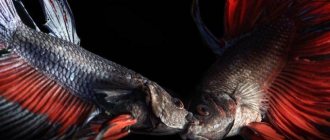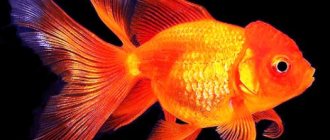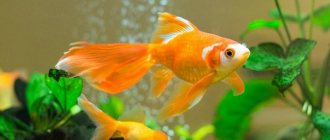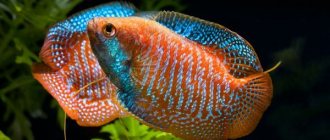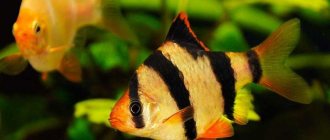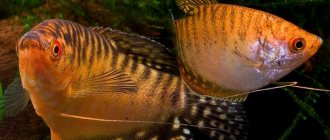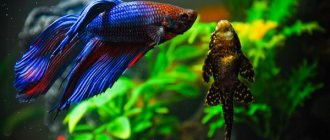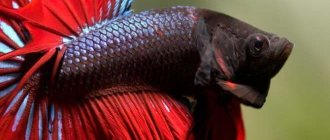Many people know the myth that tells that one of the Greek goddesses was born from sea foam. This story is fiction and will forever remain a legend. However, in fact, there are living creatures that are born in foam, albeit from fresh water. We are talking about labyrinth fish. These include Siamese fighting dogs. The breeding of betta fish is accompanied by a significant number of rituals and looks like a well-staged show. This process is unlikely to leave anyone indifferent.
History of betta fish
The first mention of fish dates back to the beginning of the nineteenth century, it was then that the inhabitants of Siam paid attention to these small, but lively and aggressive fish. Next, the Siamese began to crossbreed wild Bettas and created a new type of fish, calling it “biting fish.” A couple of copies of these “pieces” in 1840. the king of Siam handed over to Dr. Theodore Cantor, who in 1849. gave them the name Macropodus pugnax. 60 years later, British ichthyologist Charles Tate Regan renamed them “Rumblefish,” citing the fact that the species Macropodus pugnax already existed in nature.
It is known that the betta fish appeared in Paris in 1892, in Germany in 1896, and in 1910 it appeared in the United States from Frank Locke of San Francisco, California. By selecting these fish, he got a “new” fish, calling it Betta Cambodia - one of the first color variations of Betta Splendens. The history of Betta's appearance in Russia is not truly known.
There are several versions. The first is associated with aquarist V.M. Desnitsky, who allegedly in 1896. brought exotic species of fish and plants from Singapore, but it is not known for sure whether there were betta fish among them. The second version says that aquarist V.S. Around the same period, Melnikov bred a number of labyrinth fish in Russia. By the way, a competition for the best fighting fish was established in his honor. And the latest version says that fighting fish were brought by the Frenchman G. Seysel, and all the descendants in Russia and Europe came from his fish.
Habitat in nature
Betta was first described in 1910. It lives in Southeast Asia, Thailand, Cambodia, and Vietnam. It is believed that its homeland is Thailand, but with its popularity, it is difficult to say for sure whether this is so. "Betta" gets its name from the Javanese "Wuder Bettah". Now in Asia it is most often called “pla-kad”, which means biting fish. Interestingly, in Thailand they call it “pla kat Khmer”, which can be translated as a biting fish from the land of the Khmers.
- Why does a cat need a tail?
- Chinchilla
- Dog breeds
- Urban dog breeds
- Origin of the cat
- Hypoallergenic dogs
- splendens is one of more than 70 species described in the genus Betta, and there are another 6 or more species of fish that are not classified. The genus can be divided into two groups, one carries the fry in the mouth, the second raises it in a foam nest.
The betta fish lives in standing or slow-moving waters with dense vegetation. Lives in canals, ponds, rice fields, as well as in medium and large rivers. Refers to labyrinthine fish that can breathe atmospheric oxygen, which allows them to survive in very harsh conditions.
Description of the betta fish
Wild fish, which are abundant in Thai markets, are caught from their natural habitats only for sale; they are not used in battles. Such fish have a nondescript, elongated body and a complete lack of fighting qualities.
By nature, the color of such fish is inconspicuous, the fins are of medium length. However, thanks to the work of various breeders since the end of the 19th century, a great many excellent specimens have been presented to the world, some of which are quite expensive.
This species from the labyrinthine order has an amazing distinctive feature - they can breathe atmospheric air. This process occurs through a special organ in the form of a labyrinth. Due to their ability to absorb atmospheric air, they are not afraid of high concentrations of carbon monoxide in water. You just need to always leave a little space between the water and the cover glass for the betta to breathe. If fish do not have access to atmospheric air, they will suffocate. It is also necessary to take into account the location of the aquarium with fish. This should be a place where there are no drafts, as they can cause the bettas to become sick and die due to the cold air.
What types of betta fish are there?
About 70 species of fighting fish are already known. Representatives of each species have an individual, unusually bright color. All the variety of species is divided according to the shape and size of the fins and the nature of the color. According to the shape and size of the fins, bettas are veiled-tailed, half-moon-tailed, crown-tailed, double-tailed, round-tailed, delta-tailed, brush-tailed, flag-tailed, poster-tailed and royal. Based on color, cockerels are classified into single-color, two-color, and multi-color cockerels.
Let's look at the most famous types:
- Veiled-tailed cockerel. The veiled-tailed cockerel is the very first variant bred by breeders. This variety became the ancestor of all known today. Fish of this species have a gorgeous flowing tail fin.
- Crescent cockerel . The Crescent Cockerel is a fish with a large veiled tail, the side rays of which turn 180 degrees. The fins on the chest, back and near the anus are just as long and lush. The body color of specimens of this species is two-colored with a very bright fin on the tail.
The following types of this type are derived:
- The half-moon cockerel is the result of hybridization between the half-moon and the crown-tailed cockerel.
- Feathertail cockerel - the tail rays of such specimens branch out.
- Rosetail cockerel - the rays of the tail of this fish intertwine, forming chic ruffles.
3. Crown-tailed cockerel. The crown-tailed cockerel is the owner of a chic tail that is like a royal crown. The outermost caudal rays protrude beyond its limits, and the partition between them may be interrupted.
There are three types of such cockerels:
- Single Rays have single tail rays;
- Double Ray – double tail rays;
- Multi Cross Ray – the rays of the tail are crossed.
4. Two-tailed cockerel. Double-tailed cockerel - the name of the fish indicates that its tail at the base is divided into two parts.
- Brush-tailed cockerel . The brush-tailed cockerel - its tail has an original shape, similar to a flat brush, a tongue of flame from a fire, or the tip of a spear.
- Cockerel poster . The poster cockerel, also known as the short-tailed cockerel, is a hybrid form that is distinguished by short fins on the back and tail. The caudal fin is wider than it is long. The English name for this species, Pla Kat, translates to “biting fish.” A type of poster betta with dissected fin tips is called a crowntail.
- Delta cockerel . The Delta cockerel is similar in appearance to veil-tailed cockerels, but in this species the rays of the tail are rigid and when moving they form a wide isosceles triangle (this looks like the Latin letter “delta”). The outer tail beams can rotate at an angle of 130 degrees.
Care and maintenance
Betta fish are considered unpretentious and easy to care for, but some conditions must be met.
Volume
Bettas can be kept in both small (10-15 l) and large aquariums. One individual requires 3-4 liters of water. If the aquarium is large, then it can be divided into several parts by partitions. In this case, several males can be kept in one container at the same time without compromising their health.
The partitions are made of transparent non-toxic material with small holes for water circulation. It is better to plant tall plants next to them to block the fish’s view and reduce unwanted encounters.
Cockerels are capable of jumping quite high out of the water, so the top of the aquarium is equipped with a mesh or lid with holes for air passage
Water
The optimal water temperature is 24-28°C, but the cockerels tolerate a decrease to 18°C quite well. It should be remembered that a long stay in a too cold aquarium is fraught with diseases for them. Control is carried out using a thermometer.
Cockerels are undemanding to the quality and composition of water. However, it is better to stick to the following limits: hardness 4-15, acidity 6.0-7.5. To prevent illness and reduce stress, it is recommended to use special salt (half a teaspoon per three liters of water).
A prerequisite is regular water replacement. In large aquariums it is carried out once every two weeks, and in small aquariums - once every three days. It is imperative to remove all remaining food from the bottom.
Air
The cockerel is a labyrinth fish, that is, it breathes not only with gills, but also with an additional special organ. In it, the blood is saturated with air, which the fish captures with its mouth. Therefore, aeration is not very important for cockerels, but it is advisable to install a filter. It can be of low power, since these fish do not like strong currents.
It is also important that the surface of the water is not completely overgrown with plants, so that the betta can rise to the surface and take in air. Sometimes it happens that a bacterial film forms on the surface of the water. It needs to be removed. This can be done using a sheet of paper, placing it on the surface of the water, and then removing it along with the film.
Priming
For cockerels, river sand or gravel is quite suitable. You can also use purchased colored primer. Before placing it in the aquarium, it must be calcined or washed under running hot water.
Plants
In an aquarium with bettas, you can use both artificial and live plants. When choosing artificial algae, special attention should be paid to the absence of sharp edges, which could damage the bettas’ fins. The best option is silk plants. However, live algae is still better, as it helps maintain biological balance in the aquarium. They should occupy at least a third of the space. Living plants need to be looked after - thinned out in a timely manner, and rotten leaves removed. They are planted in the ground or in special pots.
Decorations and lighting
Cockerels love to swim between various obstacles, so shelters made of stones, driftwood, grottoes, etc. would be quite appropriate. The main thing is that all decorations should have no sharp edges and be environmentally safe. Do not install the aquarium in direct sunlight.
Potential problems and benefits
Having become interested in breeding cockerels at home, an amateur must decide whether he is doing this for fun or pursuing certain goals. You can try to breed your own genetic line of fish, selecting from each offspring the producers that best meet the intended standards. Some aquarists breed bettas commercially.
Maybe you will be the one to create a new form of betta fish?
In any case, steps should be taken to ensure that the raised fry are marketed. This could be advertisements on the Internet or establishing contacts with pet stores. Otherwise, the number of young fish will become so large that there will be nowhere to keep them. After all, each couple, with good care, is capable of producing offspring once every 2-3 weeks. Even in the event of the death of a third of the total number of fry, partial culling, after each spawning you can get 200-300 young cockerels.
Regardless of the purpose for which cockerels are bred, it is always an exciting spectacle. Watching a neon-painted male mating dance around a pale female is worth the time and effort.
Nutrition
The aquarium betta fish is prone to obesity, so overfeeding it is not recommended. Betta fish should be fed 1-2 times a day, and the amount of food should be given exactly as much as the fish can eat in 15 minutes. Food can be live, dry or frozen. Remains of uneaten food are removed.
Zooplankton, bloodworms, tubifex, artemia, daphnia, and earthworms are used as live food for cockerels. Dry food is available in the form of flakes and granules, created specifically for bettas. To avoid gastrointestinal diseases and excessive water pollution, preference should be given to live and frozen food.
How long do they live (disease prevention)
Betta fish live relatively short lives - 2-4 years.
In order for your pet to feel good and look beautiful, you need to pay attention to how the fish feels. Diseases can significantly reduce the life expectancy of a betta, so it is necessary to regularly prevent the disease, and at the first noticeable symptoms of illness, begin treatment immediately. To reduce the chance of fish getting sick, you need to keep your aquarium clean. It is also worth monitoring the quality of live food. Under no circumstances should you throw it into the aquarium along with the water in which it was kept. Treat the feed. To prevent diseases, it is recommended to regularly give vitamins to aquarium bettas.
It is quite easy to notice that a betta is sick. Sick males are less active, swim sluggishly, and try to hide. Also pay attention to their fins: sound the alarm if there are holes in them or if the animal is holding them to its body. Symptoms of some diseases include raised scales, spots on the body, breathing problems and a bloated body.
If these signs are detected in a fish, it is necessary to urgently isolate it and begin treatment.
AQUARIUM FISHES THAT BUILD NESTS
Compatibility
Bettas in the aquarium are not exactly friendly; they are real hunters and do not like to share their territory. But this does not mean that males should live in the aquarium all alone. On the contrary, the “right” neighbors will have a positive effect on the betta. If for some reason a neighbor's fish dies, do not rush to replace it with a new fish; the betta should get used to the loss. The only strict rule is that there should not be two males in the same aquarium at the same time. But a female and a male will get along well in the same aquarium. Female bettas are considered calmer and friendlier, but their character cannot be predicted. To make betta fish friends with other inhabitants of the underwater world, read the basic rules:
If the aquarium is more than 100 liters and there are a lot of decorations and shelters in it, there is no need to worry about the neighbors, the betta fish will find a decent shelter.
Betta splendens are loyal to various species of catfish, including swordtails, tetras, platies and minors. They are great friends with zebrafish. Usually there are no problems with such neighbors. However, when moving in a new neighbor, at first it is worth observing the behavior of the bully. You should not transfer various snails to male roosters, incl. ampularia. During aggression, cockerels can bite off their whiskers. An aquarium with a betta should contain fish that love warm water. For example, a predator will not get along with a goldfish, since the goldfish needs cooler water.
Do not introduce brightly colored fish into a community aquarium; a Siamese predator may see it as a rival and beat it to death. They absolutely do not get along with similar predators, for example, cichlids or piranhas.
Breeding cockerels
Males become sexually mature at the age of 3-4 months. Before mating, the female, with her modest coloring, folds her fins in front of the stunningly beautiful male, thereby showing complete submission. If the female is not ready to mate, she immediately takes flight. If she is ready, then she slowly approaches the male. After this, mating begins, a ritual not as magnificent as the male war dance, but no less graceful.
Then the couple is seated, the first male is placed in the spawning aquarium, and after a couple of hours or the next day the female is added. The temperature in the spawning aquarium is raised to 27-300C. The male begins building the nest almost immediately or the next day after landing for spawning (stimulation may be necessary). In most cases, the nest is quite large, built from saliva and air bubbles, but it may also be thin, which he will begin to complete in the future.
Spawning occurs after 1-2 days (in some cases within a week). If spawning of males does not occur for a long time, then stimulation of spawning is necessary. During spawning, the male picks up the eggs with his mouth and places them in the nest. The male also takes care of the eggs and larvae. During this period, it must be well fed with bloodworms or well-washed tubifex.
During spawning, the female lays 100-250 eggs. The spawned female is removed from the spawning aquarium, leaving the eggs in the care of the male. Larvae appear depending on temperature and water parameters after 20-60 hours. For better development of eggs, boiled water can be added to the spawning aquarium (the temperature of the added water should be the same temperature as in the spawning aquarium). After the fry appear, the male must be removed from the aquarium. Reduce the water level in the aquarium to 5 cm. If the spawning aquarium is small, the fry need aeration of the water until they develop a labyrinth organ.
Betta fish begin their life with eggs fertilized during spawning with a diameter of up to 1 mm; the betta fish remains in this stage for an average of 36 hours (largely depends on the water temperature). After two days, larvae appear in the nest. At first it is just a “tailed egg”. On the third day, the larva acquires a body shape more reminiscent of a fish, but with a large white belly, the so-called yolk sac - a parental gift of a supply of nutrients for the first time.
2-3 day old fry measure 2.5-3mm, they are completely transparent with pronounced black eyes. Through the transparent body of the fry, developing internal organs are visible. At this time, the first food is introduced into the aquarium. This could be an egg yolk, ciliates, or starter dry food for fry. Cockerel fry develop quite quickly and by two weeks of age reach a size of 5-6 mm.
Preparing for spawning
Two weeks before spawning, the cockerels are placed in separate containers, separating the pair. During the specified time, the fish are well fed with live food, allowing the male to gain the desired shape and complete the process of maturation of eggs in the female. During these 14 days, you can place the vessels in which the future parents are kept side by side so that the producers gradually get used to each other.
In parallel with this, it is necessary to start growing live food for future cockerel fry - ciliates. You need to take a two-liter jar, fill it with water after using the siphon, add 1 square meter. cm piece of dry banana peel and one teaspoon of milk. After the liquid clears in color after a few days, it will not be difficult to see clusters of ciliates.
Do not fill the spawning tank with water until it is full and be sure to add live plants.
An aquarium with a volume of 15-20 liters is selected as a spawning tank. You can use a larger container, for example, 40 liters, then it only needs to be filled halfway with water. A heater is placed in it, maintaining the temperature around 26-27 degrees. There is no need to equip the reservoir with a compressor and filter. To make it easier for the male to build a nest, you can place a small amount of small algae floating on the surface. Riccia, pistia and the like are suitable. To ensure the safety of the female, you need to place a shelter at the bottom so that she can hide from her temperamental partner.
The absence of soil in a specially designated spawning container is very important. The eggs can easily fall between stones or get lost in the sand.
After a two-week period, the male is planted in a prepared spawning tank. If its color has acquired a noticeably brighter color, and it soon begins to create a nest, then a pregnant female ready for spawning can be placed next to it. It should have a full, stuffed belly, stripes on the sides and a clearly enlarged grain on the belly.
If the cockerel is distracted from the nest and is too actively and furiously chasing his partner, then the aquarium should be divided with a transparent partition for a couple of days, after which it should be removed.
If the fish do not proceed to spawning, the water temperature should be slightly increased and softened.
If the aggressiveness of the fish has noticeably decreased and the nest is ready, then the next stage in the breeding of males begins.
Buying fish
This is an inexpensive and not scarce type of aquarium fish; they are sold in any pet store at a price of 150 rubles.
The only rule is that sudden changes in temperature are contraindicated, so if you decide to buy a cockerel, it is better to do it in the summer, or come to the store in a warm car. Many people practice taking a thermos with them, and transporting fish in it is a great idea, it works. Don’t forget about the rule for fry – buy them together with other fish if you decide to stock them with several species.
Feeding
Although fish are omnivores in nature, they even eat some algae, their main diet is insects. In natural reservoirs they feed on insect larvae, zooplankton, and aquatic insects.
In the aquarium they eat all types of live, frozen, and artificial food.
There should be no problems feeding your betta. The only thing is, try to diversify it - alternate types of food to maintain health and color at a high level.
Owner reviews
gruz
Until recently I had a male betta. He was handsome, his fins and tail were long and fluffy. It was blue. My cockerel lived for literally three months. He ate everything that everyone else did and wasn’t picky. And at one fine moment he probably became bored, because he has an obstinate character by nature, since all the other fish are larger than him, my rooster found his opponent in the form of his reflection in the glass. Started to fight with him. He fought for four days, became all fluffy, taking on a fighting appearance. Then, apparently, he became upset that he was “not being defeated” and died, apparently from grief. It’s not for nothing that the betta is called a “fighting fish,” and you can’t put two males in one aquarium. This is such a strange fish. But very beautiful!
VIKA0712
The cockerel fish is truly gorgeous, with a bright color. When she swims imposingly in the aquarium, it’s impossible to take your eyes off! She is not particularly picky about food or care. Holding such a fish is a pleasure. The only problem is that you can’t add other fish to the bettas in the aquarium and they themselves fight among themselves for leadership, gnawing off each other’s fins and tails and then dying. Without knowing all this, we added the cockerel to the fish in the aquarium, he killed everyone and was left swimming alone in the aquarium. Thanks to an irresponsible seller who did not warn us, we were left without fish. What a sad story!
Redwall
I am an aquarist with 8-10 years of experience. During this time, all kinds of fish lived with me. We also had experience with cockerels. There's a reason they're called fighting fish!
A couple of years ago I had a 60 liter aquarium with goldfish, macropods, neons and two bettas. At first, the two cockerels got along well, but then one began to behave extremely aggressively: he began to eat the fins of the other. As a result, they constantly pursued each other. A month later, the prey fish died.
The actions of the betta fish did not stop there. He switched to the fins of other fish. Now the cockerel and the macropod have declared war on each other: they began to eat each other’s tails. But the rest of the fish suffered a little: the cockerel ate their tails too. As a result, we bought a separate aquarium, where the cockerel was moved.
By itself, he is a slow fish, unpretentious, very beautiful! Doesn't require much space. But if you place him with other fish, then be careful: the fish can show a fighting character and justify its second well-deserved name. I recommend it for beginner aquarists.
irinich
When I saw the cockerels for the first time, I couldn’t resist buying such a beauty. In the aquarium there were barbs, neons, a couple of catfish, and crayfish. The store assured that the cockerel would live peacefully with all these fish. I took one to try. As soon as he was launched into the aquarium, he immediately began chasing neons and barbs. He bit off their fins and tails. I didn’t really get into trouble with the catfish, but I tried. He also showed particular aggression towards the crayfish, but the crayfish was purple. As a result, after a week, almost all the fish had their tails bitten, so the cockerel had to be isolated and then taken back to the store. In general, the fish turned out to be pugnacious, so if peaceful fish live in the aquarium, it is better not to buy a cockerel.
Dme
Cockerel is truly a very beautiful fish. The unpretentiousness of these fish can only be compared with goosefish. In a small aquarium you can keep one fish for quite a long time. There are no special requirements for the composition of water or feed. But these fish have a very serious drawback. They cannot get along with any other inhabitants of the aquarium. By nature, aunties are fighting fish. I had the imprudence to put a cockerel in an aquarium with goops and swordtails for two days.
During this time, the cockerel tore off the tails of almost all the inhabitants of the aquarium and drove them into thickets of aquatic plants. He took up a strategic position near the feeder and carefully made sure that no one could swim past. Of course, I immediately put it in a separate container as soon as the opportunity arose. If you want to get yourself such a fish, then you need to keep the cockerel alone or be prepared for the fact that all the other inhabitants will be without tails.
Korica
Representatives of this breed can be very beautiful, bright and graceful. But they are fighting fish and therefore the beauty of these fish cannot be used in large quantities. The territory of the aquarium must belong to one male of this species, otherwise fights without rules cannot be avoided. They can also attack other veil-tailed fish, mistaking them for a rival.
The females of these fish are also constantly in tension with other neighbors. The ideal option for a betta is a small aquarium planted with plants, in which one male and two or three females will live. And maybe you will be lucky to see the love games that these fish have, which are mesmerizingly beautiful; and watching how the male takes care of the clutch is very touching. For those who love slow-moving fish and are simply amazed by the beauty of the betta, you just need to consider their temperament and continue to enjoy your pets!
Video
How to distinguish a female from a male
In male fish, the girls are smaller and look modest (their color is paler, and the fins and tail are smaller and more inconspicuous).
The male has a striking appearance:
- developing tail;
- lush fins;
- bright, iridescent color, which becomes especially colorful during a fight with another representative of the genus and during the spawning period.
The body of males can reach 5 cm in length, females are smaller - up to 4 cm. In mature females, eggs can be seen in the abdomen. In fish of many varieties, readiness to spawn is marked by the appearance of stripes along the body. Fish do not live long, about 3 years, and reach sexual maturity by 3 - 4 months of life. Fish of about this age are sold in pet stores. But the main difference is the growth on the abdomen, which can be taken onto the stuck eggs (ovipositor). The male has nothing like this.
Male fins
Breeders have created many varieties of domestic cockerels, which differ both in the shape of the tail and fins, and in body color.
The names of the selection forms speak eloquently about the shape of the fins:
- crescent-tailed betta fish;
- crowntails;
- veil-tailed;
- two-tailed;
- round-tailed;
- racemetails;
- flagtails;
- posters;
- deltatails;
- elephant ear;
- comb-tailed;
- giant or royal (with short fins, but a large body).
Body color also suggests a variety of shapes:
- monochrome;
- two-color;
- multicolor
Specifics of the color of females
They are colored more modestly than males (in pale colors), but thanks to the work of breeders, you can already find varieties of female cockerels that are not inferior in color to males, and even with elongated fins.
Behavior
Cockerels are also called fighting fish, but they are not predators; on the contrary, they are quite peaceful inhabitants of water bodies. They have earned their reputation due to behavioral characteristics within the species, the tendency of males to aggressively defend their territory and compete with relatives. Sometimes a male may also show cruelty towards a female that he “didn’t like.” However, even in their aggression, cockerels show nobility.
Fish of the labyrinth family, which includes bettas, use atmospheric air to breathe and are forced from time to time to rise to the surface of the water to stock up on it.
This plays an interesting role in the behavior of betta fish, in which a kind of code of honor can be traced:
- when during a fight one of the opponents has to rise for air, becoming vulnerable, the second one waits for him in a fighting position without attacking;
- if there are more than two males in the aquarium, they fight in turns, strictly “one on one”, the rest patiently wait for their turn;
- the winning fish fights with a new opponent, the loser “eliminates from the game.”
